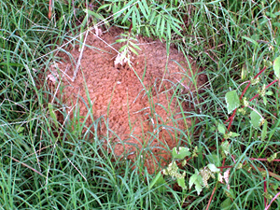Pesky Fire Ants!
go.ncsu.edu/readext?287242
en Español / em Português
El inglés es el idioma de control de esta página. En la medida en que haya algún conflicto entre la traducción al inglés y la traducción, el inglés prevalece.
Al hacer clic en el enlace de traducción se activa un servicio de traducción gratuito para convertir la página al español. Al igual que con cualquier traducción por Internet, la conversión no es sensible al contexto y puede que no traduzca el texto en su significado original. NC State Extension no garantiza la exactitud del texto traducido. Por favor, tenga en cuenta que algunas aplicaciones y/o servicios pueden no funcionar como se espera cuando se traducen.
Português
Inglês é o idioma de controle desta página. Na medida que haja algum conflito entre o texto original em Inglês e a tradução, o Inglês prevalece.
Ao clicar no link de tradução, um serviço gratuito de tradução será ativado para converter a página para o Português. Como em qualquer tradução pela internet, a conversão não é sensivel ao contexto e pode não ocorrer a tradução para o significado orginal. O serviço de Extensão da Carolina do Norte (NC State Extension) não garante a exatidão do texto traduzido. Por favor, observe que algumas funções ou serviços podem não funcionar como esperado após a tradução.
English
English is the controlling language of this page. To the extent there is any conflict between the English text and the translation, English controls.
Clicking on the translation link activates a free translation service to convert the page to Spanish. As with any Internet translation, the conversion is not context-sensitive and may not translate the text to its original meaning. NC State Extension does not guarantee the accuracy of the translated text. Please note that some applications and/or services may not function as expected when translated.
Collapse ▲Have you experienced problems with fire ants over the last couple of years? Fire ants have spread throughout much of the southern and eastern parts of NC, and they are moving west. The main question most of us have is: How do you control these horrible ants?
Fire ant mounds vary in size due to the size of the colony. For example, a mound that is 2 feet in diameter and 18 inches high may contain about 100,000 workers, several hundred winged adults, and one queen. The mounds are often located in open areas such as pastures, fields, large lawns, etc. They can even be found around house foundations or inside houses.
During the spring and summer, winged males and females leave the mound and mate in the air. After mating, females become queens and may fly as far as 10 miles from the parent colony. However, most queens descend to the ground within much shorter distances. Only a very small percentage of queens survive after landing. Foraging ants, especially other fire ants, kill most queens. If a queen survives, she sheds her wings, burrows into the ground, and lays eggs to begin a new colony. In the late fall, many small colonies of fire ants will appear. Many of the colonies will not survive the winter unless the weather is mild.
Fire ants prefer oily and greasy foods. They also feed on many other insects and, from that standpoint, could be considered beneficial. To find food, workers forage around their mound often in underground tunnels that radiate from the mound. If the mound is disturbed, ants swarm out and sting the intruder.
Controlling these ants is almost impossible. However, your goal should be to manage the ants with chemical control and non-chemical control tactics. There are two approaches to chemical control. Each mound can be treated with an insecticide, or it can be broadcast over a wide area infested with fire ant colonies. Individual mound treatments are usually more environmentally friendly and effective. Mounds can be treated with a liquid or dust insecticide or with insecticidal bait. If a liquid is used, the mound must be drenched at a rate of approximately 1 gallon per 6 inches of mound diameter. Then, thoroughly wet the ground to a distance of about 2 feet around the mound. The reason for this is that you need to reach the queen in order to kill the colony.
Ant baits are extremely effective. These baits are essentially a mixture of an insecticide and a food that is attractive to fire ants. The worker ants carry particles of the bait back to the mound and feed them to the immature ants and the queen. Keep in mind that even when the bait kills the queen, the workers may be active inside the mound for several weeks before the colony finally disappears.
Broadcast treatments should only be used in the case of potential human harm or when high mound densities are present over large areas. One disadvantage to broadcast treatments is that they can alter ant communities by killing all the native ants and turning the ant community into a dominated fire ant community.
The key to reducing fire ant infestations indoors is prevention, which means removing exposed food sources that may attract them. Properly labeled indoor insecticides can be used if nests are found inside dwellings or buildings. Baits are not recommended for indoor use due to the chance of attracting more ant species indoors.
For more information about fire ants and their management, contact your local N.C. Cooperative Extension office. For the Franklin County Center contact 919-496-3344.





